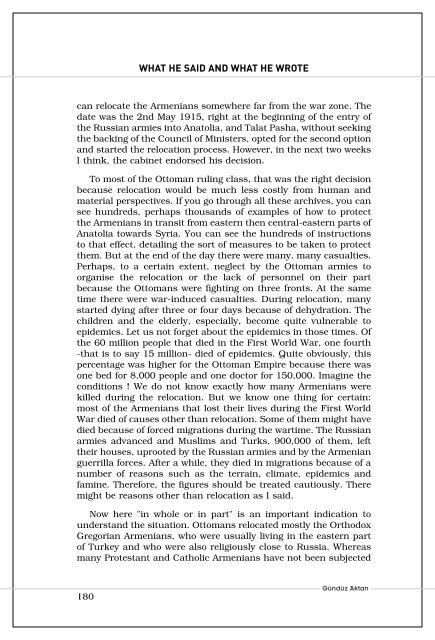gunduz-aktan-kitap-soyledikleri-ve-yazdiklari
gunduz-aktan-kitap-soyledikleri-ve-yazdiklari
gunduz-aktan-kitap-soyledikleri-ve-yazdiklari
Create successful ePaper yourself
Turn your PDF publications into a flip-book with our unique Google optimized e-Paper software.
WHAT HE SAID AND WHAT HE WROTE<br />
can relocate the Armenians somewhere far from the war zone. The<br />
date was the 2nd May 1915, right at the beginning of the entry of<br />
the Russian armies into Anatolia, and Talat Pasha, without seeking<br />
the backing of the Council of Ministers, opted for the second option<br />
and started the relocation process. Howe<strong>ve</strong>r, in the next two weeks<br />
I think, the cabinet endorsed his decision.<br />
To most of the Ottoman ruling class, that was the right decision<br />
because relocation would be much less costly from human and<br />
material perspecti<strong>ve</strong>s. If you go through all these archi<strong>ve</strong>s, you can<br />
see hundreds, perhaps thousands of examples of how to protect<br />
the Armenians in transit from eastern then central-eastern parts of<br />
Anatolia towards Syria. You can see the hundreds of instructions<br />
to that effect, detailing the sort of measures to be taken to protect<br />
them. But at the end of the day there were many, many casualties.<br />
Perhaps, to a certain extent, neglect by the Ottoman armies to<br />
organise the relocation or the lack of personnel on their part<br />
because the Ottomans were fighting on three fronts. At the same<br />
time there were war-induced casualties. During relocation, many<br />
started dying after three or four days because of dehydration. The<br />
children and the elderly, especially, become quite vulnerable to<br />
epidemics. Let us not forget about the epidemics in those times. Of<br />
the 60 million people that died in the First World War, one fourth<br />
-that is to say 15 million- died of epidemics. Quite obviously, this<br />
percentage was higher for the Ottoman Empire because there was<br />
one bed for 8,000 people and one doctor for 150,000. Imagine the<br />
conditions ! We do not know exactly how many Armenians were<br />
killed during the relocation. But we know one thing for certain:<br />
most of the Armenians that lost their li<strong>ve</strong>s during the First World<br />
War died of causes other than relocation. Some of them might ha<strong>ve</strong><br />
died because of forced migrations during the wartime. The Russian<br />
armies advanced and Muslims and Turks, 900,000 of them, left<br />
their houses, uprooted by the Russian armies and by the Armenian<br />
guerrilla forces. After a while, they died in migrations because of a<br />
number of reasons such as the terrain, climate, epidemics and<br />
famine. Therefore, the figures should be treated cautiously. There<br />
might be reasons other than relocation as I said.<br />
Now here "in whole or in part" is an important indication to<br />
understand the situation. Ottomans relocated mostly the Orthodox<br />
Gregorian Armenians, who were usually living in the eastern part<br />
of Turkey and who were also religiously close to Russia. Whereas<br />
many Protestant and Catholic Armenians ha<strong>ve</strong> not been subjected<br />
180<br />
Gündüz Aktan



